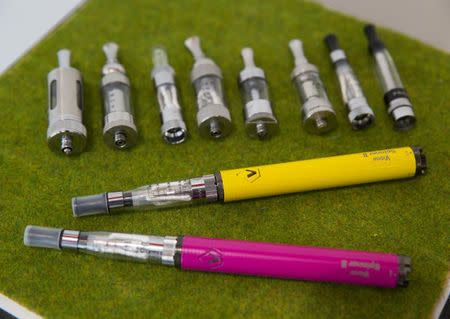Kids who use flavored e-cigs more likely to want to try cigarettes

By Kathryn Doyle (Reuters Health) – U.S. kids who use flavored e-cigarettes more often intend to start smoking traditional cigarettes than kids who did not use flavored vapes, according to a 2014 national survey. And among teens who already smoke cigarettes, those who also use flavored vapes have less intention to quit. “Our study provided strong evidence for association between flavored e-cigarette use and susceptibility to smoking,” said lead author Hongying Dai of Children’s Mercy Hospital in Kansas City, Missouri. “Within never-smokers, we found flavored e-cigarette users were associated with high odds of intention to smoke cigarettes in the future.” The researchers used the National Youth Tobacco Survey, a cross-sectional survey of kids in grades six through 12 in all 50 states. In 2014, about 22,000 students completed the survey, which included questions about using e-cigarettes in the past 30 days. They also answered questions about their current tobacco smoking status, history and intention for the future. About three-quarters of kids had never smoked. But about 3 percent of those never-smokers had used an e-cigarette at least once in the previous month. More than half of those who had used e-cigarettes said they used flavorings like mint, alcohol, candy, fruit or chocolate. Six percent of kids were current smokers and about half of these kids also used e-cigarettes, most often flavored ones, in the previous month, according to their responses. Overall, about 60 percent of e-cigarette users chose flavored options. Among never smokers, 58 percent of kids who used flavored vapes said they intended to start smoking traditional cigarettes, compared to 47 percent of kids who used non-flavored vapes and 20 percent of those who did not vape at all, as reported in Pediatrics. For current smokers, 24 percent of those who also used flavored vapes intended to quit, compared to 34 percent of those who used non-flavored vapes and 33 percent of those who did not use vapes at all. “Previous studies have investigated e-cigarette use but did not specialize on flavored e-cigarettes,” Dai told Reuters Health by email. “We found a majority of youth are particularly interested in flavored e-cigs.” But all the studies so far that indicate e-cigarette use may lead to smoking for youth are based on one point in time or only one year of follow-up, she said. Longer-term studies would need to confirm those findings, she said. “This study does not show e-cigarettes are definitely a gateway to smoking cigarettes,” said Shu-Hong Zhu, principal investigator of the California Smoker’s Helpline, who was not part of the new study. “It shows that students who tried e-cig are more interested in cigarettes than students who have not tried e-cig,” but is not sure evidence of a gateway from one to the other. Different age groups may use e-cigarettes in different ways; older smokers may use them to help quit, but young people don’t seem to be using them that way, Dai said. “In May 2016, the U.S. Food and Drug Administration finalized a rule extending its authority to regulate e-cigarettes, cigars, hookah tobacco, and pipe tobacco, along with other emerging tobacco products, but this rule does not prohibit flavored e-cigarettes,” Dai said. “Tobacco companies have been using flavors to entice youth into vaping,” she said. “Brands and flavors of e-cigarettes are flourishing on the market, including flavors such as candy crush, gummy bear, and bubble gum.” More than 60 percent of current tobacco users in U.S. middle and high schools, or nearly 1.58 million youngsters, had used flavored e-cigarettes in 2014, Dai said. E-cigarette flavoring should be regulated at the federal and state level, she said. SOURCE: http://bit.ly/2eFHfR7 Pediatrics, online November 7, 2016.

